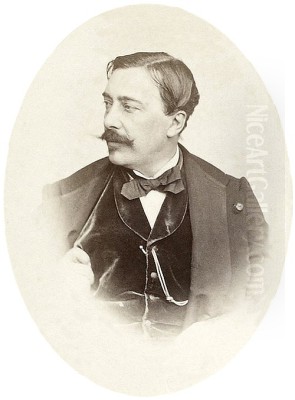
Alfred Émile Léopold Stevens stands as a significant figure in nineteenth-century European art, a Belgian painter who achieved immense fame in Paris, the vibrant heart of the art world during his time. Born in Brussels in 1823 and passing away in Paris in 1906, Stevens dedicated his career primarily to capturing the essence of modern femininity, particularly the lives of elegant women within the sophisticated interiors of Parisian high society. His work skillfully navigates the currents of Realism, Academic polish, and the burgeoning influence of Impressionism, creating a unique artistic signature that resonated deeply with his contemporaries and continues to hold historical importance.
Stevens was not merely a painter of pretty pictures; he was an astute observer of his era, documenting the fashions, moods, and social nuances of the Second Empire and the early Third Republic. His canvases offer a window into a world of luxury, introspection, and quiet domestic drama, rendered with exceptional technical skill and a refined aesthetic sensibility. He moved comfortably within the artistic and literary circles of Paris, forging connections that both influenced his work and cemented his reputation as a leading artist of his generation.
Early Life and Artistic Formation in Brussels and Paris
Alfred Stevens was born into an environment steeped in art. His father, Jean François Léopold Stevens, was a former military officer and a passionate art collector and dealer. This familial connection to the art world undoubtedly shaped Alfred's early inclinations. His elder brother, Joseph Stevens (1816-1892), became a respected animal painter, and his younger brother, Arthur Stevens (1825-1890), was an influential art critic and dealer. This network provided Alfred with both support and an inherent understanding of the artistic landscape from a young age.
His formal artistic training began in Brussels under François-Joseph Navez, a prominent Belgian neoclassical painter who had himself been a pupil of the great Jacques-Louis David. This early grounding in classical principles provided Stevens with a strong foundation in drawing and composition, elements that would remain evident even as his style evolved. However, the lure of Paris, the undisputed center of artistic innovation, proved irresistible.
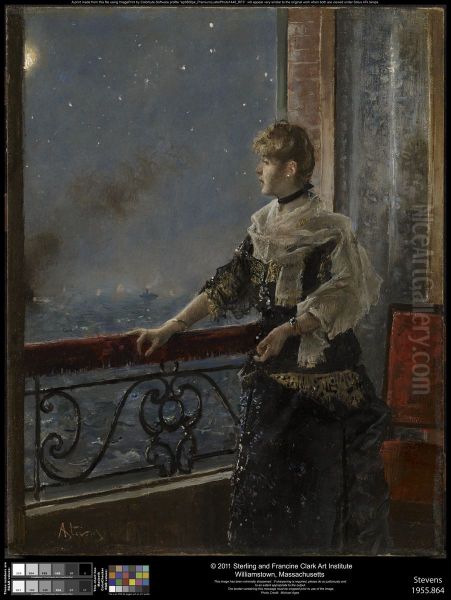
Around 1844, Stevens moved to Paris to continue his studies. He briefly attended the prestigious École des Beaux-Arts, where he is believed to have spent some time in the orbit of Jean-Auguste-Dominique Ingres, a master of line and classical form. While the direct influence of Ingres might seem subtle in Stevens' mature work, the emphasis on precise draughtsmanship learned during this formative period remained a crucial underpinning of his technique. Paris also exposed him to a wider range of artistic currents, including the burgeoning Realist movement.
The Emergence of a Parisian Painter: Realism and Modern Life
Initially, Stevens explored historical and genre subjects, sometimes with a social realist edge, reflecting the influence of Belgian artists like Henri Leys or Gustave Wappers. An early work, Ce qu'on appelle le vagabondage (What is Called Vagrancy, 1854), depicted soldiers rounding up the poor, demonstrating a concern for contemporary social issues. This painting garnered attention at the 1855 Exposition Universelle in Paris, hinting at his potential but not yet fully defining his future path.
The pivotal shift occurred as Stevens turned his gaze towards the contemporary Parisian scene, specifically the lives of well-to-do women. He abandoned overt social commentary for intimate portrayals of modern femininity. This move coincided with his integration into the Parisian art world. He became a regular participant in the official Paris Salon, the most important exhibition venue of the time, where his works began to attract significant critical acclaim and patronage.
His studio became a meeting place, and he frequented cafés like the Guerbois and later the Nouvelle Athènes, hubs for artistic and intellectual debate. Here, he forged crucial friendships with leading figures of the avant-garde. He developed a close relationship with Édouard Manet, a revolutionary figure whose work challenged academic conventions. They shared mutual respect and even, reportedly, the services of the same model, Victorine Meurent, famous for posing for Manet's Olympia and Le Déjeuner sur l'herbe.
Stevens also befriended Edgar Degas, another keen observer of modern Parisian life, and the American expatriate James McNeill Whistler, whose aesthetic sensibilities sometimes paralleled Stevens' own refined approach. Association with the poet and influential art critic Charles Baudelaire further immersed Stevens in discussions about modernity and its representation in art. These interactions placed him at the crossroads of established Salon success and emerging avant-garde ideas.
Master of Texture and Light: Stevens' Signature Style
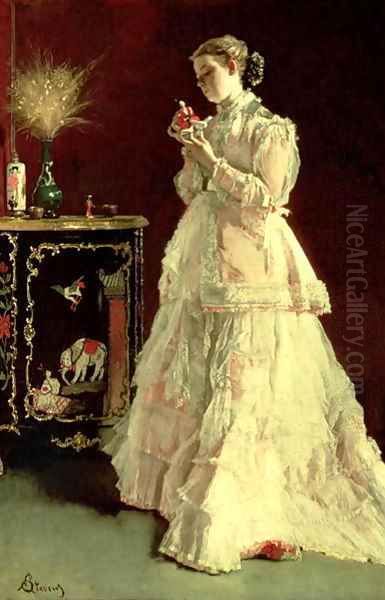
Alfred Stevens developed a highly distinctive style characterized by meticulous technique, a sophisticated understanding of light and color, and an almost obsessive attention to detail, particularly in the rendering of fabrics and textures. His paintings celebrated the material world of his subjects – the luxurious sheen of satin dresses, the delicate transparency of lace, the hard gleam of porcelain, the rich patterns of oriental rugs, and the intricate details of furniture and objets d'art.
His brushwork was typically smooth and controlled, allowing for a high degree of finish that appealed to the tastes of Salon juries and wealthy collectors. Unlike the Impressionists who often emphasized visible brushstrokes to capture fleeting moments, Stevens generally maintained a polished surface, aligning him more closely with academic traditions in terms of execution, even while his subject matter felt distinctly modern. This technical virtuosity became a hallmark of his work.
Light plays a crucial role in Stevens' interiors. He masterfully depicted the way natural light falls through a window, illuminating a figure or highlighting the textures within a room. His color palettes were often rich and harmonious, employing subtle tonal gradations to create depth and atmosphere. He demonstrated a particular skill in rendering different shades of white, cream, and grey, often used for the elegant gowns worn by his female subjects.
While primarily a figure painter, the settings in his works are never mere backdrops. The interiors are carefully composed environments that reflect the status and taste of their inhabitants, often filled with fashionable items that contribute to the overall narrative or mood of the painting. These meticulously rendered details provide valuable insights into the domestic aesthetics of the Parisian upper class during the latter half of the nineteenth century.
Echoes of the Past: The Influence of Dutch Masters
Art historians often note the strong affinity between Stevens' work and that of the seventeenth-century Dutch Masters, particularly Johannes Vermeer and Gerard ter Borch. Like Vermeer, Stevens excelled at depicting intimate interior scenes bathed in subtle light, often featuring solitary female figures engaged in quiet activities – reading a letter, looking in a mirror, or lost in thought. The sense of stillness and psychological introspection found in many of Stevens' paintings echoes the mood of Vermeer's masterpieces.
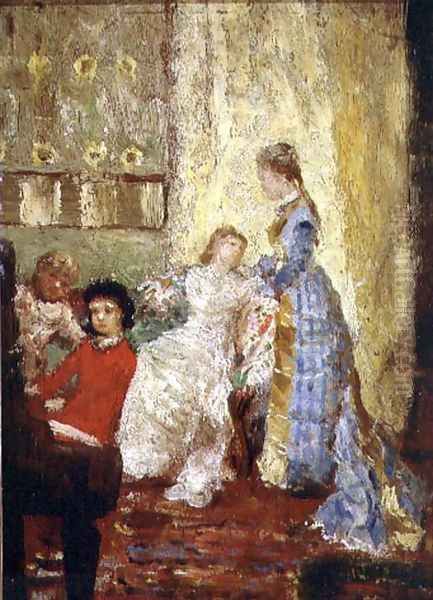
From painters like Ter Borch, Stevens seems to have inherited a fascination with rendering luxurious fabrics, especially satin. The ability to capture the precise sheen, weight, and drape of expensive textiles was a skill highly prized in Dutch genre painting, and Stevens revived this tradition with remarkable success in his depictions of contemporary Parisian fashion. This connection to the Dutch Golden Age provided his modern subjects with a lineage rooted in artistic tradition, adding a layer of historical resonance to his work.
This dialogue with the past distinguished Stevens from some of his more radical contemporaries. While embracing modern subject matter, he grounded his art in established European painting traditions, skillfully blending contemporary observation with time-honored techniques. This fusion contributed significantly to his broad appeal, allowing him to bridge the gap between academic expectation and modern sensibility.
Japonisme: Embracing the Exotic
Alfred Stevens was among the first European artists to become fascinated by Japanese art and artifacts, a phenomenon known as Japonisme that swept through Paris in the latter half of the nineteenth century. Following the reopening of Japan to the West in the 1850s, Japanese prints, ceramics, textiles, and decorative objects began to flood the European market, captivating artists with their novel aesthetic principles.
Stevens became an avid collector of Japanese art, and elements derived from these objects frequently appear in his paintings. His female subjects are often depicted holding Japanese fans, wearing kimonos or gowns with oriental motifs, or situated in interiors adorned with Japanese screens, porcelain vases, and prints. These objects were not just decorative props; they signified sophistication and fashionable taste among the Parisian elite.
Beyond the inclusion of specific objects, Japonisme subtly influenced Stevens' compositional strategies. The asymmetrical arrangements, flattened perspectives, and decorative patterning found in Japanese woodblock prints offered alternatives to traditional Western compositional norms. While Stevens never fully abandoned Western conventions of perspective and modeling, the influence of Japanese aesthetics can sometimes be detected in the way he arranged figures and objects within the picture plane, adding a layer of exoticism and decorative flair to his work. His engagement with Japonisme places him alongside contemporaries like Whistler, Manet, and Degas, who also explored the artistic possibilities offered by Japanese art.
The Height of Success: Recognition and Acclaim
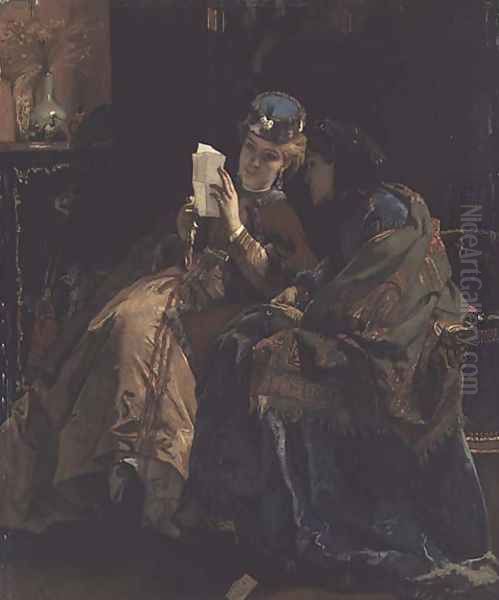
The 1860s and 1870s marked the zenith of Alfred Stevens' career. His paintings were highly sought after by collectors in France, Belgium, and America. He achieved significant official recognition, culminating in his triumph at the 1867 Exposition Universelle in Paris. He exhibited eighteen paintings, a testament to his prolific output and established reputation, and was awarded a first-class medal. More significantly, he was promoted to Officer of the Legion of Honour, a prestigious accolade from the French state that confirmed his status as a leading figure in the contemporary art scene.
His success was built upon works that perfectly captured the zeitgeist of the Second Empire. Paintings like Le Bain (The Bath, 1867), depicting a woman preparing for her bath with luxurious accessories surrounding her, or Le Sphinx de Paris (The Parisian Sphinx, c. 1867), showing a fashionable woman mysteriously veiled, exemplified his focus on intimate moments and the allure of the modern woman. Tous les bonheurs (All the Happinesses, c. 1861), portraying a woman gazing lovingly at her child, showcased his ability to convey tender emotion within an elegant setting.
Other notable works from his mature period include Retour dans le monde (Return from the Ball), Souvenirs et regrets (Memories and Regrets, 1874), and Young Woman with a Bouquet of Flowers. These titles often hint at underlying narratives or emotional states, inviting viewers to speculate about the inner lives of the women depicted. L'artiste dans son atelier (The Artist in Her Studio) is particularly interesting, showing a female painter at work, reflecting the increasing presence of women in the art world. His works consistently demonstrated technical brilliance and a keen sense of psychological nuance.
He also received commissions for portraits, including from members of the Belgian royal family, further solidifying his standing. His financial success allowed him to live comfortably and maintain a prominent position in Parisian society. He was elected an honorary member of the Société Nationale des Beaux-Arts in 1889, recognizing his continued contribution and esteemed position within the French art establishment.
Later Years: Seascapes and Impressionist Influences
Beginning in the 1880s, Stevens faced recurring health problems, possibly related to the materials he used in his studio. On medical advice, he began spending extended periods away from Paris, particularly on the Normandy coast near Honfleur and Trouville. This change of scenery prompted a significant development in his art: a newfound dedication to marine painting and landscape.
His coastal scenes often display a marked shift in style compared to his earlier interior subjects. Influenced perhaps by the plein-air practices of Impressionist painters like Claude Monet or Eugène Boudin, whom he would have encountered in Normandy, Stevens adopted a looser, more fluid brushwork and a lighter, brighter palette to capture the effects of light on water and sky. Works like Moonlight showcase his ability to render atmospheric conditions and the ephemeral qualities of the natural world.
This period was also marked by financial difficulties, despite his earlier success. Taste was changing, and the highly finished style that had brought him fame was perhaps becoming less fashionable compared to the bolder experiments of the Impressionists and Post-Impressionists. A contract with the prominent Parisian art dealer Georges Petit provided some financial stability during these years. Petit supported Stevens, allowing him to spend a three-year period recuperating and painting by the sea, resulting in a significant body of marine work.
Even during this later phase, Stevens did not entirely abandon his interest in the female figure. He often incorporated elegantly dressed women into his coastal scenes, creating a dialogue between his established subject matter and his newer landscape interests. These later works demonstrate his adaptability and his continued engagement with contemporary artistic trends, particularly the Impressionist fascination with light and atmosphere.
Friendships, Rivalries, and Artistic Dialogue
Alfred Stevens' long career in Paris placed him in close contact with many of the most important artists and writers of his time. His relationships were complex, involving friendship, mutual influence, and occasionally, implicit rivalry or differing artistic philosophies.
His friendship with Édouard Manet was significant. Both artists were interested in depicting modern life, though their approaches differed. Manet's work was often more confrontational and stylistically radical, while Stevens maintained a greater degree of polish and conventional appeal. Their shared use of the model Victorine Meurent underscores their overlapping worlds. Despite Stevens' success within the Salon system that often rejected Manet, they maintained a connection, navigating the complex dynamics of the Parisian art scene.
With Edgar Degas, Stevens shared an interest in observing contemporary urban life and the female figure. Both artists frequented similar social circles and likely exchanged ideas. Degas, like Stevens, was a master draughtsman who, despite his association with Impressionism, retained a strong connection to classical principles. Their shared fascination with Japanese prints also provided common ground.
James McNeill Whistler was another important connection. Both Stevens and Whistler were expatriates who achieved fame in Paris and London, and both shared an interest in aesthetic refinement, subtle color harmonies, and the influence of Japanese art. Their work sometimes exhibits parallel concerns, particularly in their sensitive portrayals of women and their exploration of tonalism.
Stevens' relationship with the Impressionist movement was nuanced. While friendly with key figures like Berthe Morisot, whose work he admired and who may have influenced his later seascapes, Stevens himself never fully embraced the core tenets of Impressionism. He remained committed to a higher degree of finish and detail than most Impressionists, and while his later landscapes show Impressionist influence, his primary focus remained the carefully rendered figure within an interior or, later, coastal setting. He represented a bridge between the academic tradition, the Realist impulse, and the new sensibilities emerging with Impressionism. His circle also included figures from the academic side, like Jean-Léon Gérôme, and artists with similar thematic interests like James Tissot.
Legacy and Art Historical Position
Alfred Stevens occupies a unique and important place in the history of nineteenth-century art. He was arguably the most successful Belgian painter of his generation on the international stage, achieving fame and fortune through his insightful and technically brilliant depictions of contemporary Parisian life. His work provides an invaluable visual record of the fashions, interiors, and social mores of the Second Empire and early Third Republic.
His primary contribution lies in his elevation of the genre scene depicting modern women. He imbued these subjects with psychological depth and aesthetic refinement, moving beyond mere illustration to create works of lasting artistic merit. His mastery of technique, particularly his rendering of textures and his sophisticated use of light and color, remains widely admired.
Stevens successfully navigated the complex art world of his time, achieving recognition within the official Salon system while maintaining connections with the avant-garde. He absorbed influences from various sources – Dutch Masters, Academic tradition, Realism, Japonisme, and Impressionism – synthesizing them into a distinctive personal style. This ability to blend tradition and modernity was key to his appeal.
While his fame somewhat declined in the early twentieth century as modernist movements took center stage, his work experienced renewed appreciation later on. His influence can be seen in the work of subsequent artists, including American painters like William Merritt Chase, who admired Stevens' technical skill and sophisticated subject matter. Today, his paintings are held in major museum collections worldwide, including the Musée d'Orsay in Paris, the Royal Museums of Fine Arts of Belgium in Brussels, the Metropolitan Museum of Art in New York, and the Philadelphia Museum of Art.
His later years were marked by declining health and financial struggles, and he died in relative obscurity in Paris in 1906. However, the quality and historical significance of his work ensure his enduring legacy. He remains a key figure for understanding the art and culture of nineteenth-century Paris, a masterful chronicler of elegance, intimacy, and the complexities of modern femininity.
Conclusion: An Enduring Vision of Modernity
Alfred Stevens carved a distinct path through the bustling art world of nineteenth-century Paris. A Belgian who became intrinsically associated with French art, he captured the allure and introspection of modern women with unparalleled technical skill and sensitivity. His canvases, filled with luxurious fabrics, carefully curated interiors, and subtle emotional narratives, offer a captivating glimpse into the upper echelons of Parisian society during a transformative era.
Bridging academic polish with Realist observation and absorbing influences from the Dutch Golden Age to Japanese prints and Impressionist light, Stevens created a body of work that resonated deeply with his contemporaries and secured his international reputation. His friendships with Manet, Degas, Whistler, and others placed him at the heart of artistic discourse, even as he maintained his unique stylistic identity. Though his later life brought challenges, the enduring appeal of his art lies in its exquisite craftsmanship, its psychological insight, and its elegant portrayal of modernity. Alfred Stevens remains a vital figure, celebrated for his sophisticated vision and his lasting contribution to the painting of modern life.